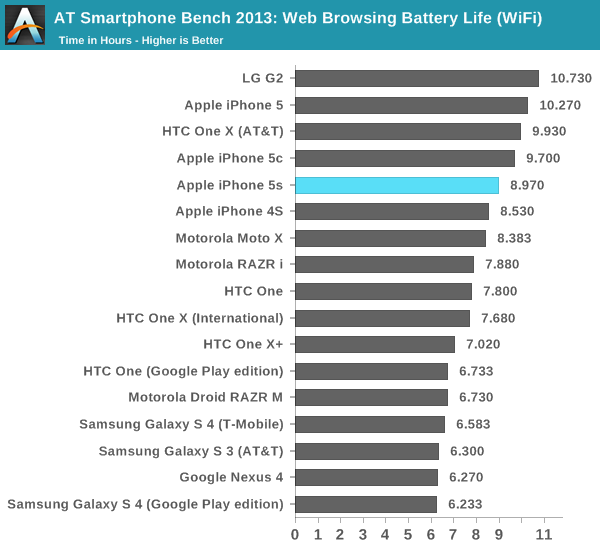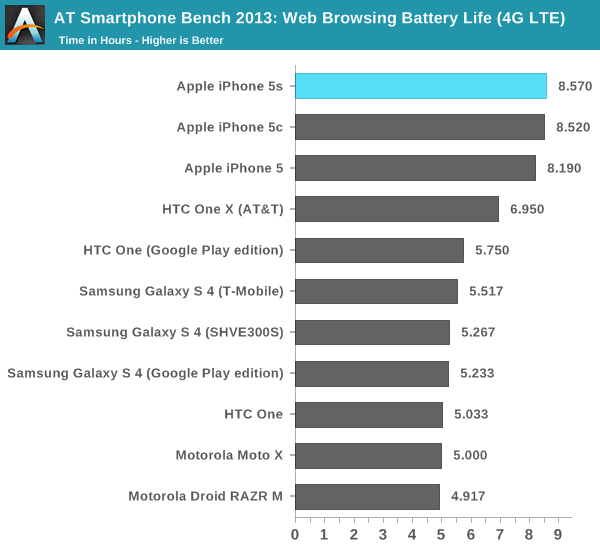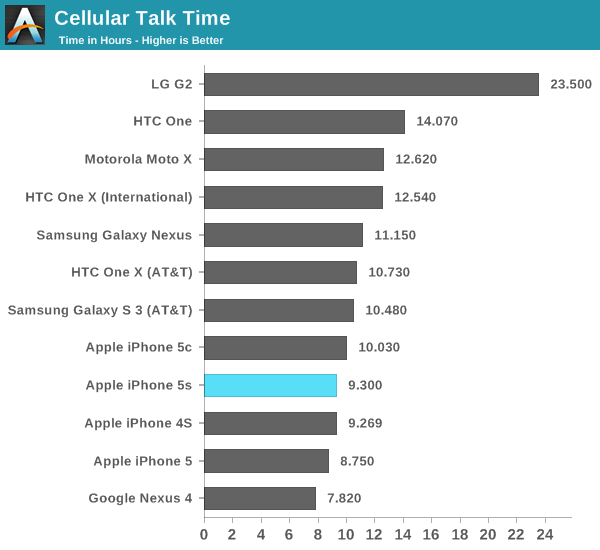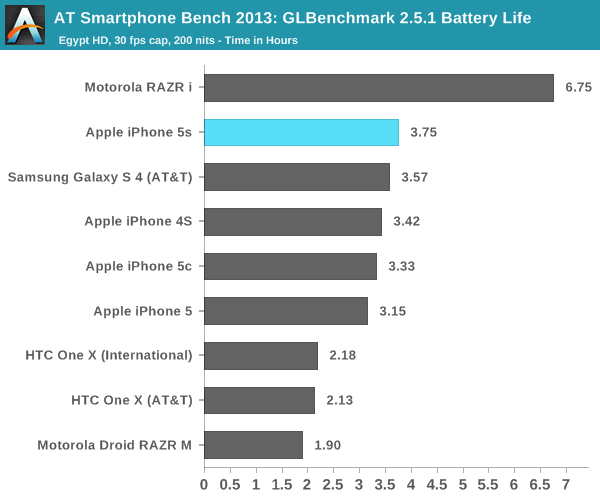The iPhone 5s Review
by Anand Lal Shimpi on September 17, 2013 9:01 PM EST- Posted in
- Smartphones
- Apple
- Mobile
- iPhone
- iPhone 5S
Battery Life
Brian did some excellent sleuthing and came across battery capacities for both the iPhone 5s and 5c in Apple’s FCC disclosures. The iPhone 5 had a 3.8V 5.45Wh battery, while the 5s boosts total capacity to 5.96Wh (an increase of 9.35%). The move to a 28nm process doesn’t come with all of the benefits of a full node shrink, and it’s likely not enough to completely offset the higher potential power draw of a much beefier SoC. Apple claims the same or better battery life on the 5s compared to the iPhone 5, in practice the answer is a bit more complicated.
Unlike previous designs, we’ve never had a half node shrink for an s-SKU. Both the iPhone 3GS and iPhone 4S stayed on the same process node as their predecessor and drove up performance. In the case of the 3GS, the performance gains outweighed their power cost, while in the case of the iPhone 4S we generally saw a regression.
The iPhone 5s improves power consumption by going to 28nm, but turns that savings into increased performance. The SoC also delivers a wider dynamic range of performance than we’ve ever seen from an Apple device. There’s as much CPU power here as the first 11-inch MacBook Air, and more GPU power than an iPad 4.
To find out the balance of power savings vs. additional performance I turned to our current battery life test suite, which we first introduced with the iPhone 5 review last year.
We'll start with our WiFi battery life test. As always, we regularly load web pages at a fixed interval until the battery dies (all displays are calibrated to 200 nits).

The iPhone 5s regresses a bit compared to the 5 in this test (~12% reduction despite the larger battery). We're loading web pages very aggressively here, likely keeping the A7 cores running at their most power hungry state. Even the 5c sees a bit of a regression compared to the 5, which makes me wonder if we're seeing some of the effects of an early iOS 7 release here.
The story on LTE is a bit different. Here we see a slight improvement in battery life compared to the iPhone 5, although the larger battery of the 5s doesn't seem to give it anything other than parity with the 5c:

Our cellular talk time test is almost entirely display and SoC independent, turning it mostly into a battery capacity test:

You can see the close grouping of the smaller iPhones at the bottom of the chart. There's a definite improvement in call time compared to the iPhone 5. We're finally up above iPhone 4S levels there.

Our Egypt HD based 3D battery life test gives us the first indication that Rogue, at least running fairly light code, can be more power efficient than the outgoing 5XT. Obviously the G6430 implemented here can run at fairly high performance levels, so I'm fully expecting peak power consumption to be worse but for more normal workloads there's no regression at all - a very good sign.










464 Comments
View All Comments
lucian303 - Wednesday, September 18, 2013 - link
I'd hardly say browser benchmarks are indicative of actual CPU or overall performance considering the huge differences in browser implementations. It tests the speed of the browser on the hardware, not the hardware itself.Whitereflection - Wednesday, September 18, 2013 - link
Normally when people write cellphone reviews, They write things that most people can understand and comparing specs that are practical and features that people actually use and care about. Keep in mind most people have one or more smartphone nowadays, You don't need to be a rocket scientist to read a review. Sadly 50% of review is written in Mars language.tech01x - Wednesday, September 18, 2013 - link
You are free to read a lightweight review from any number of less competent reviewers. There are plenty on the net. Matter of fact, plenty of other reviewers are going to incorporate Anandtech's review as a fundamental part of their review.tredstone - Wednesday, September 18, 2013 - link
that's very true. in fact there are lots of reviews that incorporate parts or Anandtech's review. if people cannot make sense of the technical info they can always go and find a review that places more emphasis on the pretty coloursMikefromSA - Wednesday, September 18, 2013 - link
I'm interested in how it performs as a phone. Did I miss that section, or was it not a consideration?tecsi - Wednesday, September 18, 2013 - link
What are the implications of non-world Qualcomm chip for China Mobile?BSMonitor - Wednesday, September 18, 2013 - link
I want to know if your OG iPhone is in Mint condition! Some day that'll sell on eBay for $2M!hydreds - Wednesday, September 18, 2013 - link
Great review Thanks. Wish you had a video review. Not that I love to see you. I am lazy to read.webdev511 - Wednesday, September 18, 2013 - link
And of course as far as handsets go this is an iOS Android only party. While I'm sure Windows Phone 8 devices would probably score lower, they certainly don't feel that way when you're using one.apertotes - Wednesday, September 18, 2013 - link
"Now going back and holding an iPhone 4S, it feels like the very opposite is true - the 4S was too heavy"And that is why Apple can't loose. No matter what they did, the last thing they settle for its going to always be perfect. At least for most reviewers.
Of course, this does not mean that the nimble Galaxy S2 was right. No, at the time, it was wrong. Lightness is only good starting on iphone 5.